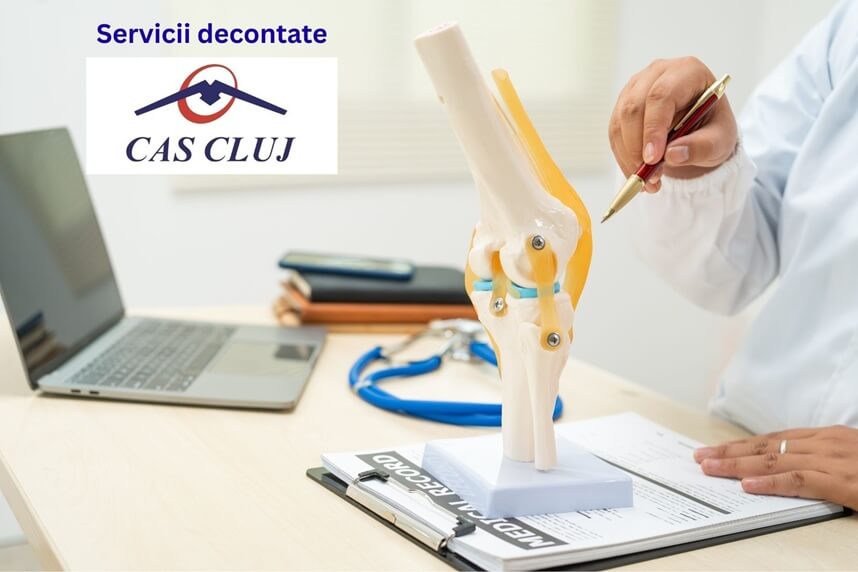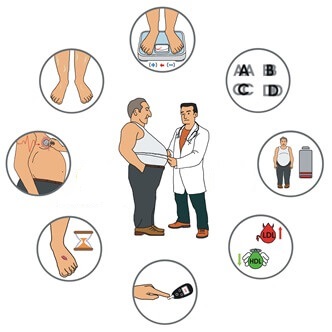See details
READ MORE
Recovery after quadriceps or patellar tendon suture
Phase I - First postoperative week
Objectives:
- Pain and swelling control
- Initiate knee mobilization
- Activation of the quadriceps muscle
Guides and activities:
- Mobility: You can fully extend the knee. The surgeon will give you information on how much you can flex your knee.
- Orthosis and crutches: You will go home using crutches and with your knee immobilized in full extension in an orthosis. In the absence of other advice from the doctor, you will use the crutches while walking and you will load on the operated leg in pain limit (even until full load).
- You can wear elastic stockings under the knees to prevent swelling of the feet. Also, do at least 10 ankle mobility exercises to prevent edema and prevent thrombophlebitis.
Exercises:
Exercises of the quadriceps muscle - to maintain muscle tone in the thigh and to strengthen the knee.Sit on your back with your knee at maximum extension as shown. Contract and maintain the contraction of the anterior muscles of the thigh (quadriceps), the knee becoming flattened and straight. If done correctly, the patella will slide proximal to the thigh muscles.
Hold the contraction for 5 seconds. Perform at least 20 repetitions 3 or 4 times a day.
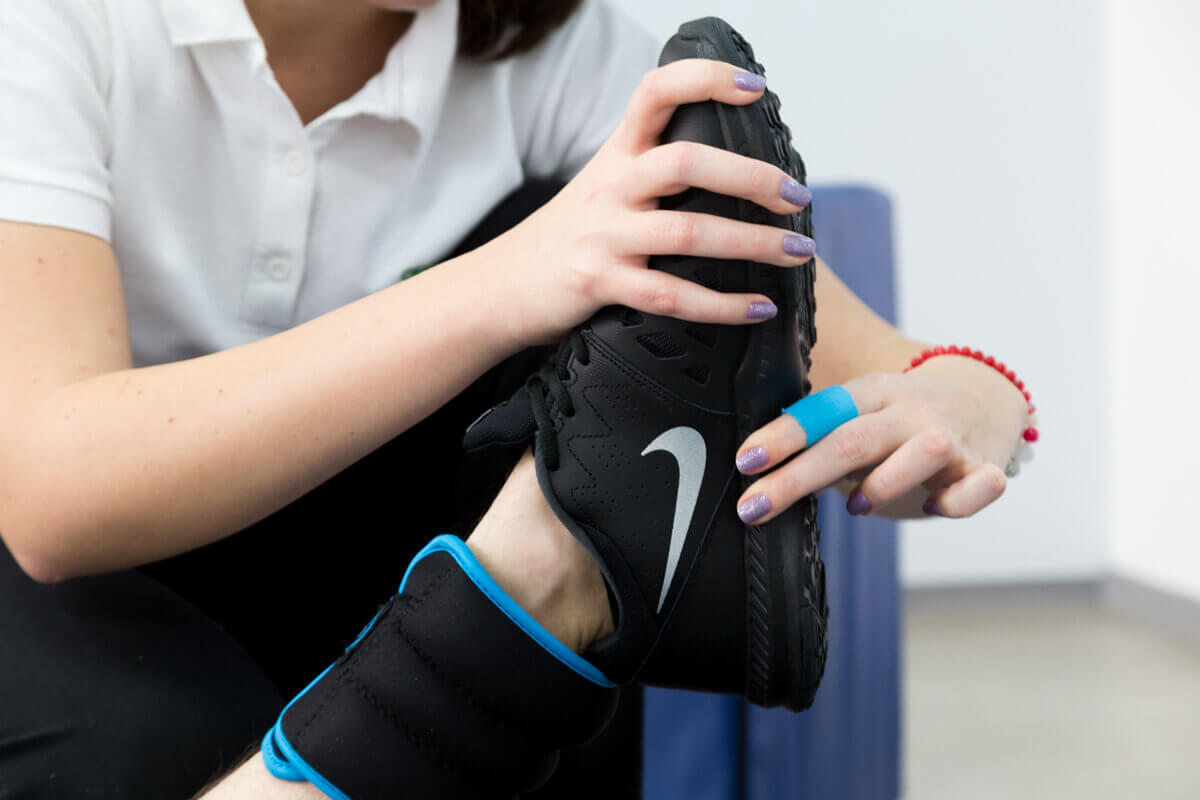
Heel support – to fully stretch your knee.
Lie on your back with a towel rolled under your heels, or sit on a chair with your heel on a stool, just like in the picture. Allow the knee to relax in extension. If the knee will not stretch completely, you can put a weight (900 g to 2.25 kg) on the thigh, just above the kneecap. Try to maintain this position for 5 minutes, 3 times a day. While maintaining this extension position, work the quadriceps exercises.
.jpg)
Heel slips – to regain your knee flexion.
While lying on your back (figure), slide your heel to bend your knee. Continue to bend the knee until you feel a "stretch" in the anterior region of the knee. Hold the flexion for 5 seconds and then ease the flexion and stretch the knee. While the knee is stretched, you can combine the exercises and repeat the quadriceps. Repeat 20 times, 3 times a day.
Sitting heel slips - to regain your knee flexion.
While sitting on a chair, pull your heel back as if you were trying to put your foot under the chair. Hold for 5 seconds and return to the extended position. You can help the opposite leg if you feel the need. Repeat this exercise 20 times, 3 times a day.
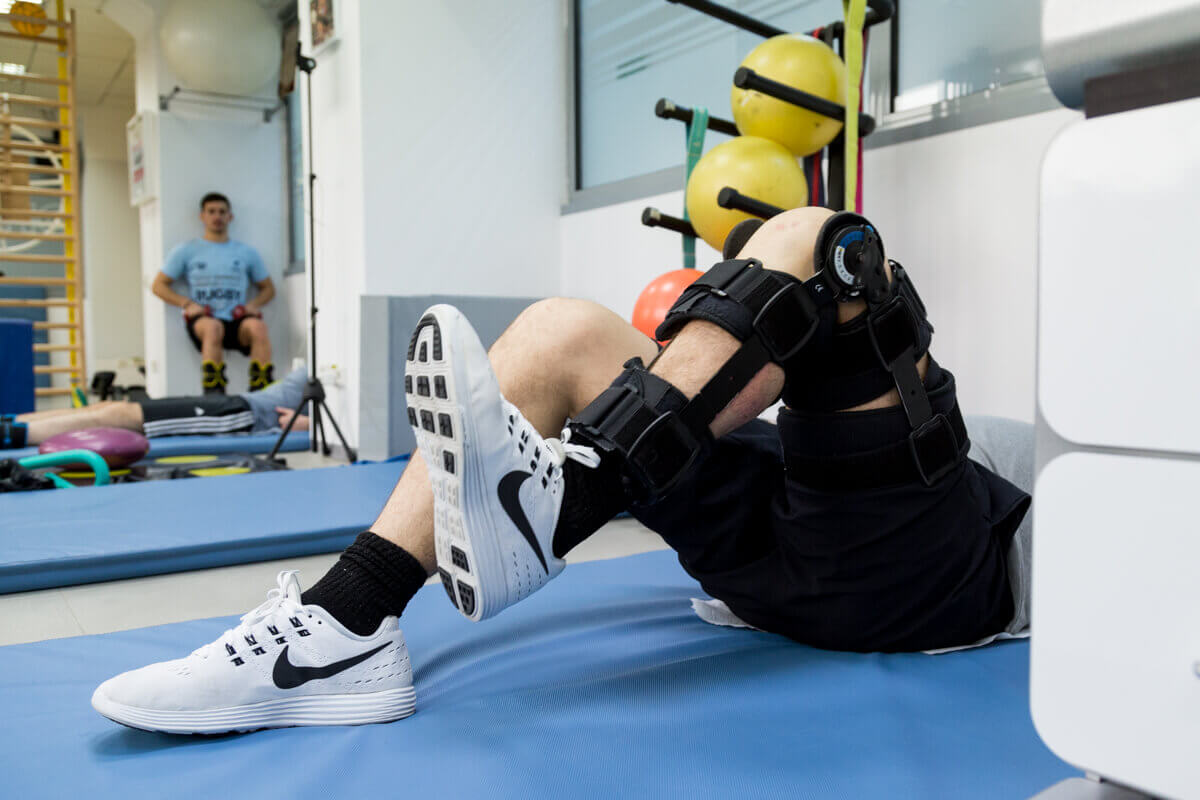
Plantar flexion and dorsiflexion of the foot - mobilize the foot up and down to stimulate circulation in the foot. Perform at least 10 such movements every hour.
Post-surgery follow up examination
At 10-14 days after surgery you will perform a medical control to follow the post-operative evolution and for ablation of sutures.
Phase 2 - 2-6 weeks postoperatively
Objectives:
- Avoid tendon overload and allow healing
- Regain knee mobility by limiting flexion to 90 degrees
- Start muscle strengthening
Knee mobilization
You can fully extend the knee. To avoid applying additional stress to the tendon, do not bend the knee more than 90 degrees.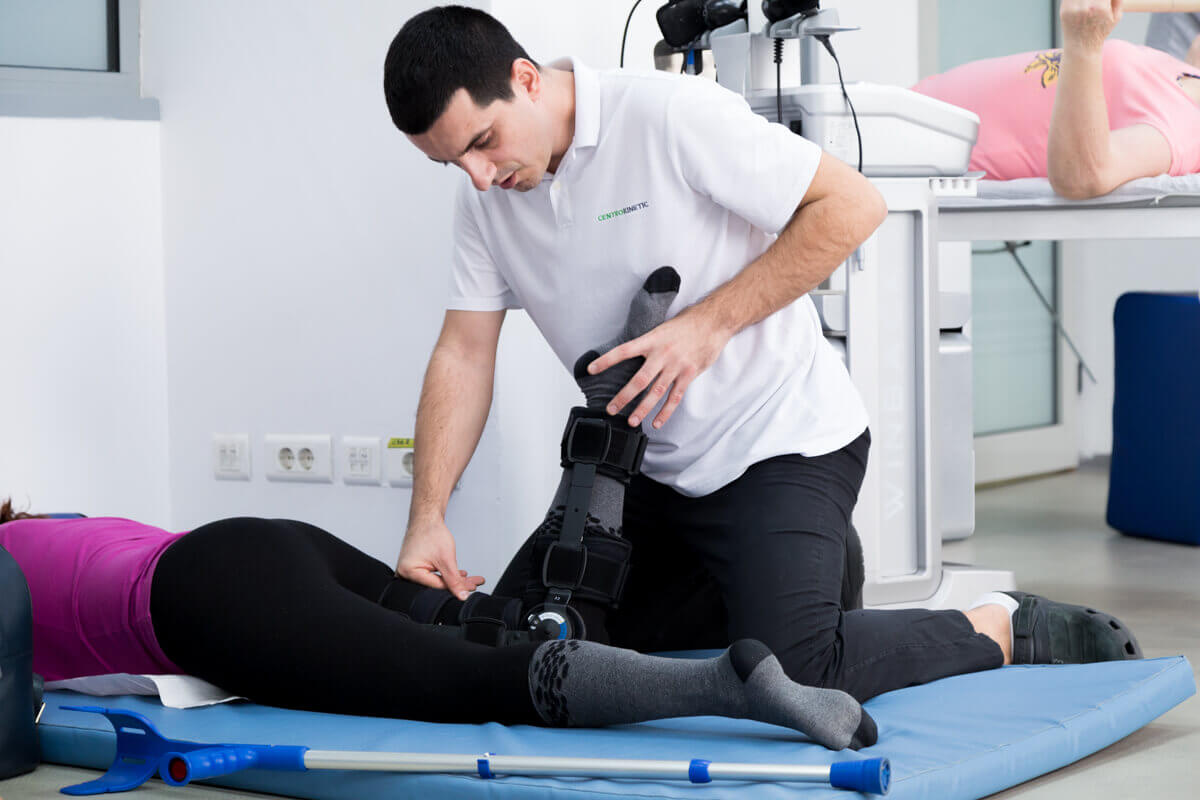
Orthosis and crutches
You will use crutches while walking, loading on the operated leg to the point of pain. Also, while walking, you will wear a knee orthosis, with it stretched in full extension.
Exercises:
Exercises of the quadriceps muscle - to maintain muscle tone in the thigh and to strengthen the knee.Sit on your back with your knee at maximum extension as shown. Contract and maintain the contraction of the anterior muscles of the thigh (quadriceps), the knee becoming flattened and straight. If done correctly, the patella will slide proximal to the thigh muscles.
Hold the contraction for 5 seconds. Perform at least 20 repetitions 3 or 4 times a day.

Heel support – to fully stretch your knee.
Lie on your back with a towel rolled under your heels, or sit on a chair with your heel on a stool, just like in the picture. Allow the knee to relax in extension. If the knee will not stretch completely, you can put a weight (900 g to 2.25 kg) on the thigh, just above the kneecap. Try to maintain this position for 5 minutes, 3 times a day. While maintaining this extension position, work the quadriceps exercises.
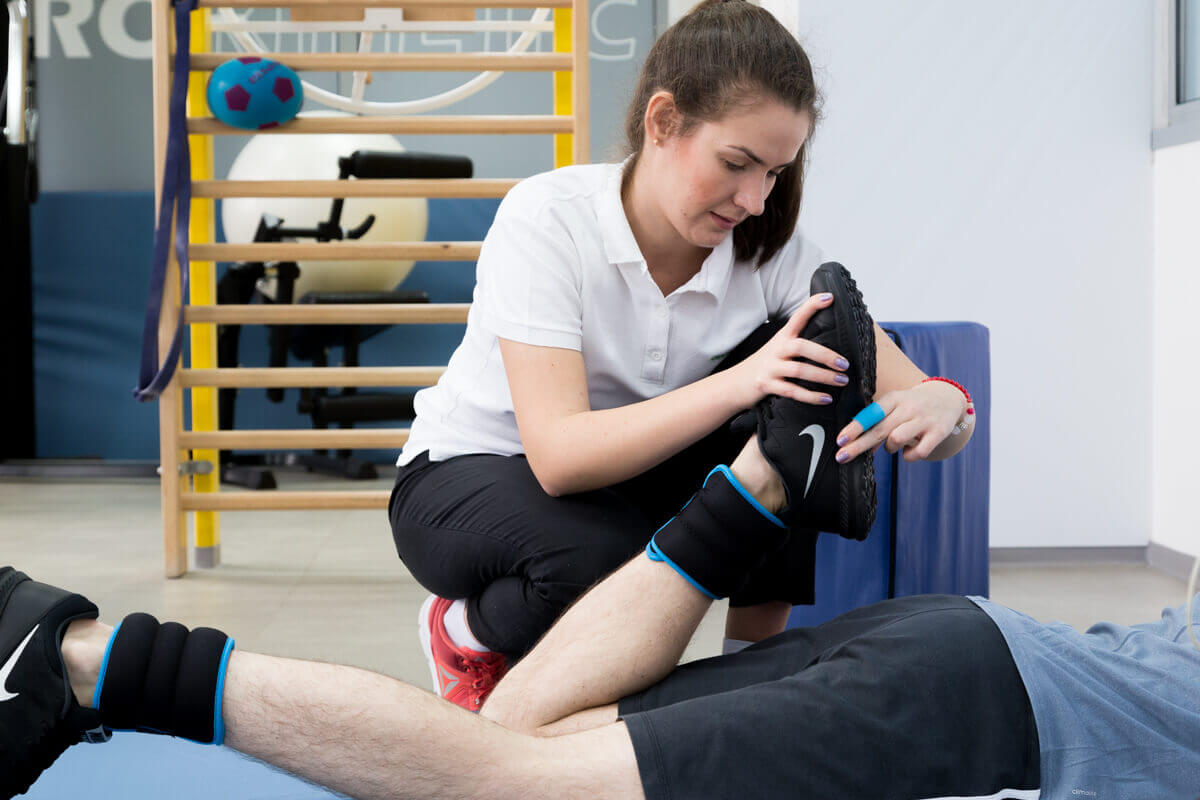
Heel slips – to regain your knee flexion.
While lying on your back (figure), slide your heel to bend your knee. Continue to bend the knee until you feel a "stretch" in the anterior region of the knee. Hold the flexion for 5 seconds and then ease the flexion and stretch the knee. While the knee is stretched, you can combine the exercises and repeat the quadriceps. Repeat 20 times, 3 times a day.
Sitting heel slips – to regain your knee flexion. While sitting on a chair, pull your heel back as if you were trying to put your foot under the chair. Hold for 5 seconds and return to the extended position. You can help the opposite leg if you feel the need. Repeat this exercise 20 times, 3 times a day.
Hip Abduction. Lie on your healthy side. The knees will be in maximum extension. Raise the operated limb to 45 degrees, as in the figure below. Hold this position for a second, then return gently. Repeat 20 times.
Peak lifts. Stand facing a table with your hands on it for balance and support. The knees will be in maximum extension. Contract the quadriceps and keep the knee in maximum extension. Get up on your toes while keeping your knees in maximum extension. Hold this position for one second, then return to the starting position. Repeat 20 times.
Plantar flexion and dorsiflexion of the foot – mobilize the foot up and down to stimulate circulation in the foot. Perform at least 10 such movements every hour.
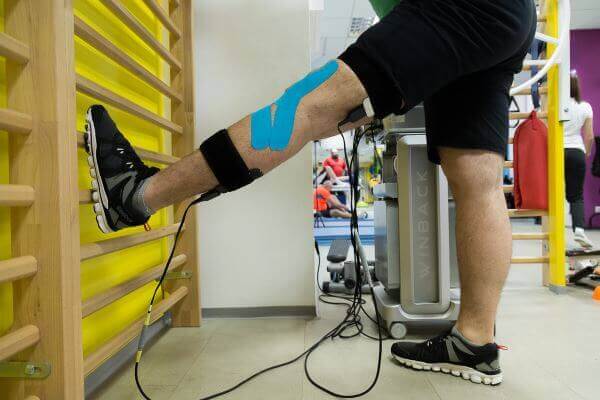
Post-surgery follow up examination
At 6 weeks after the surgery, you will perform a medical check-up to follow the postoperative evolution.Phase 3 –6-12 weeks postoperatively
Objectives:
- Walk normal
- Recover and improve the range of your knee movements
- Start muscle strengthening exercises
Exercises:
Medicinal bicycle. Use a medicinal bicycle to mobilize the knee and increase its flexion. If you cannot perform complete pedals, then keep the operated foot on the pedal and pedal back and forth until the knee bends enough to allow a complete cycle. Most people manage a complete cycle first in the opposite direction, followed by the forward direction. You can use the bike, without resistance, for 10 to 20 minutes a day. Adjust the height of the bicycle saddle so that when you are riding the bike, the knee is fully extended when the pedal is in the lowest position. Pedaling will be done with the help of the forefoot (toe), and not the heel.Heel slips - to regain your knee flexion. While lying on your back (figure), slide your heel to bend your knee. Continue to bend the knee until you feel a "stretch" in the anterior region of the knee. Hold the flexion for 5 seconds and then ease the flexion and stretch the knee. While the knee is stretched, you can combine the exercises and repeat the quadriceps. Repeat 20 times, 3 times a day.
Extension of the limb. Contract the quadriceps muscle so that the knee is flat, straight, and fully extended. Try to lift the entire operated limb off the bed or floor plane. If you can keep your knee straight up to about 45 degrees, pause for a second and then gently lower your foot back on the bed. Relax and repeat.
If your knee bends as you try to lift your limb, do not continue with these exercises. Try the quadriceps exercises again until you can lift the limb without bending the knee.
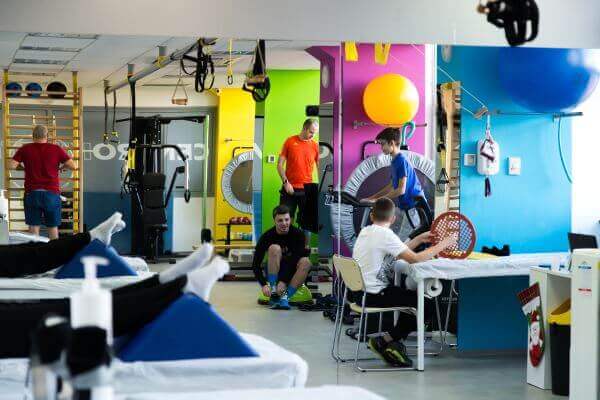
Short lifts. With your knee bent over a rolled towel or blanket, lift your leg so that your knee is fully extended. Keep your knee locked in extension for 5 seconds, then lower gently. Repeat 20 times.
Plantar flexion and dorsiflexion of the foot - mobilize the foot up and down to stimulate circulation in the foot. Perform at least 10 such movements every hour.
Peak lifts. Stand facing a table with your hands on it for balance and support. The knees will be in maximum extension. Contract the quadriceps and keep the knee in maximum extension. Get up on your toes while keeping your knees in maximum extension. Hold this position for one second, then return to the starting position. Repeat 20 times.
Slips on the wall. Stand up straight with your back and bottom touching the wall. Place your feet 30 cm away from each other and 6 cm away from the wall. Bend your knee and slide along the wall until your knees are bent at 45 degrees. Hold this position for 5 seconds and then return to the starting position. Perform 3 sets of 10-15 repetitions.

Phase 4 - 12 weeks + after surgery
Activities:
- Walking/climbing stairs: Normally you should walk without the help of orthoses and crutches. You can start going up / downstairs.
- Medical bicycle: Use a medical bicycle to strengthen your thigh muscles and improve your flexion.
- Swimming (ideal exercise)
Exercises:
Hamstring stretching - Perform these exercises in the position in the next figure. Bend forward at the hip, keeping the knee fully extended, until you feel a slight stretch in the back of the thigh and knee. Hold the stretching position for 15-20 seconds and repeat 3-5 times.
Stretching the quadriceps - This exercise is performed as in the adjacent position. Perform a movement near the heel. When you feel a stretch in the front of the thigh and knee, hold the position for 15-20 seconds for 3-5 repetitions.
Stretching the leg - In the illustrated position, keep the heel straight on the floor, the knee being in maximum extension. Lean forward at the thighs, with your hands supporting your weight. When you feel a slight stretch in the back of the leg and knee, hold this position for 15-20 seconds for 3-5 repetitions.
Hip and thigh stretching - Cross your left/right leg in front of the other. Lean-to the left/right, leaving the prominence of the right/left hip out. When you feel a slight stretch on the outer side of the hip, hold this position for 15-20 seconds for 3 or 5 repetitions.


MAKE AN APPOINTMENT
CONTACT US
SUCCESSFUL RECOVERY STORIES
MAKE AN APPOINTMENT
FOR AN EXAMINATION
See here how you can make an appointment and the location of our clinics.
MAKE AN APPOINTMENT




